#monolingual dictionaries are one thing
Text
If there's one thing I've learned from translation is that online dictionaries are often useless if not unreliable
I just had to Google tanbark, and this was the umpteenth time an image search helped me out more than any dictionary
#translation#monolingual dictionaries are one thing#but with nouns im trying to stick to bilingual dictionaries to no avail lol
0 notes
Text
all my mandarin dictionaries (and dictionary-adjacent books)
Through chatting with @don-dake and @cherrymintvampyyri, I've come to realize that I might own a less than normal number of Mandarin dictionaries. So, here's a post about all of them.
I do have two basic bilingual dictionaries (Mandarin/English): the Langenscheidt pocket dictionary and the DK visual dictionary. These are quite easy to buy and not that interesting imo, so I'm not gonna talk further about them.
I'm also going to include a couple books that aren't technically dictionaries, but are rather about etymology of characters, and that's close enough to count for me.
Okay, let's get on to the interesting stuff!
1. What Character is That? An Easy-Access Dictionary of 5,000 Chinese Characters by Ping-gam Go (second edition, 1995)
bilingual
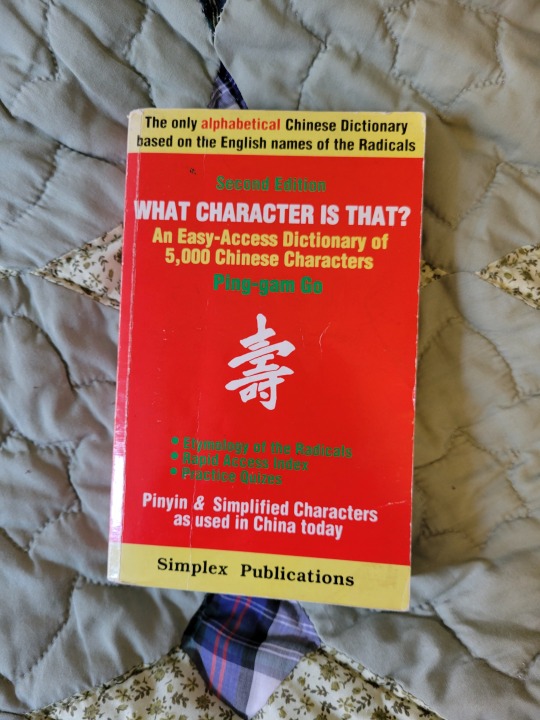
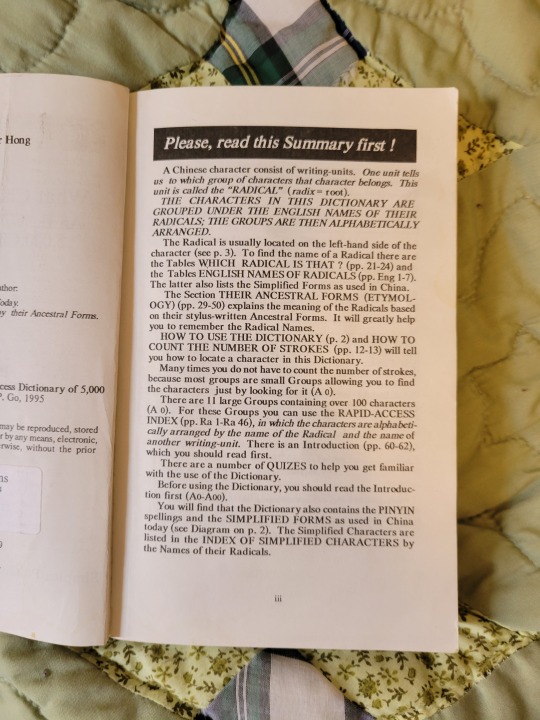



This strange little dictionary was gifted to me by a nun who went to high school with my grandma and later lived in China as a missionary. It's organized alphabetically based on the English translation of each radical?
I have not used this dictionary for actual reference ever, because I flipped through it once and realized that it was absolutely whack. But it's cool to have I guess.
2. 新华字典 第11版
monolingual
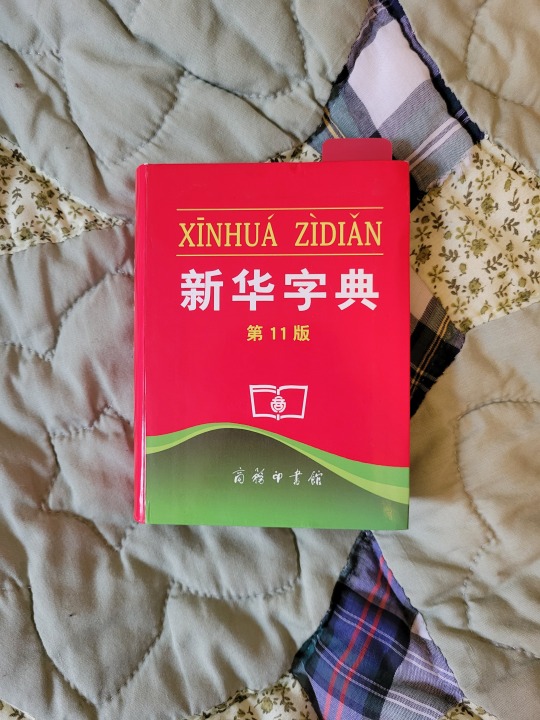
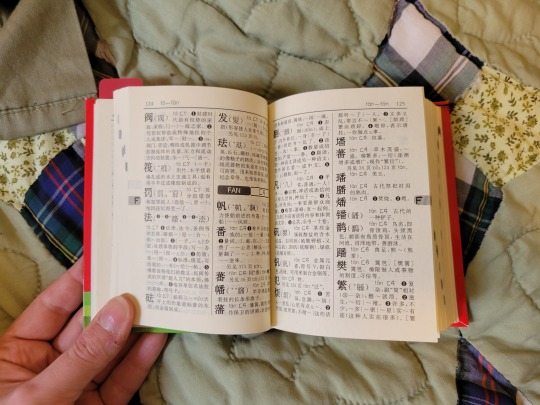


This little guy was gifted to me by a Chinese classmate back when I was in college. It's a 字典, so it's just focused on defining individual characters and providing some words featuring that character. Despite being a mainland dictionary, it also has 注音 next to each character for some reason.
It's got some neat stuff towards the back, like the periodic table and a chart of all the 節氣 solar terms.
3. 小学生全笔顺 同义词 近义词 反义词 组词 造句 成语 多音多义字 词典
monolingual
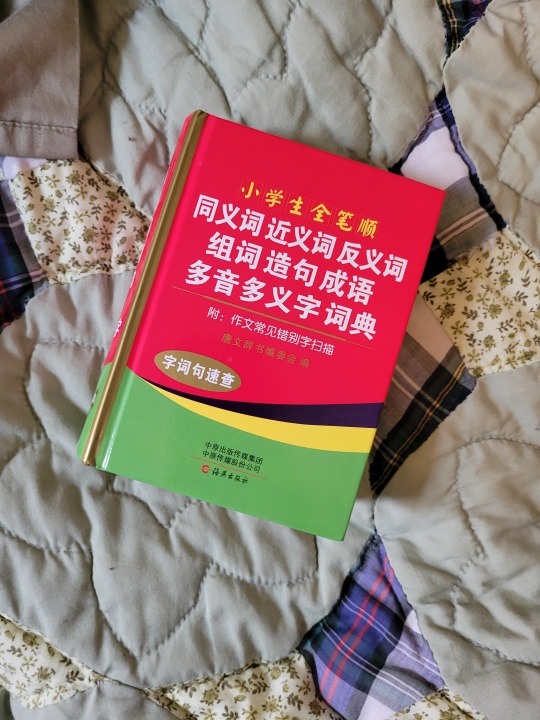
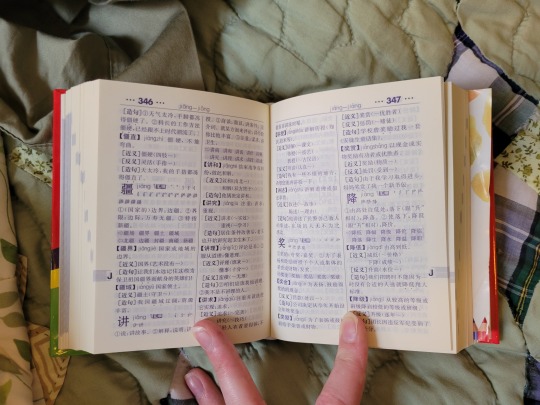

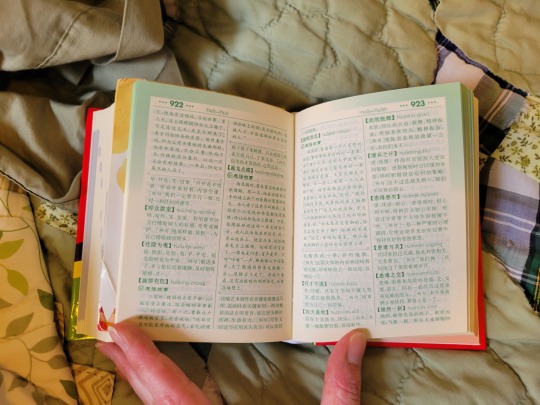
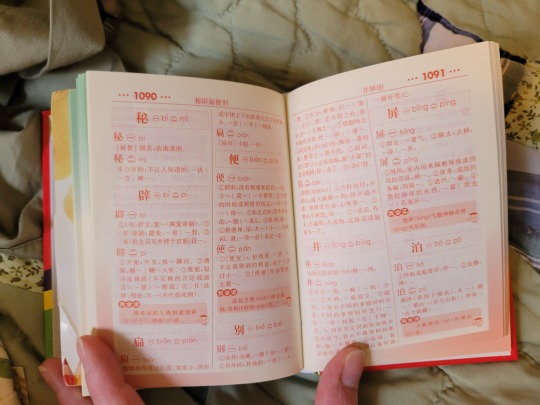
Whew, that's a mouthful. This is an actual 词典, so it defines full words. It also provides example sentences, synonyms, antonyms, and close equivalents. Then there's a section for idioms, and another section for 多音多义字.
There's also this nifty little insert with examples of words/phrases that follow common patterns of repetition.
4. 新现代汉语词典
monolingual


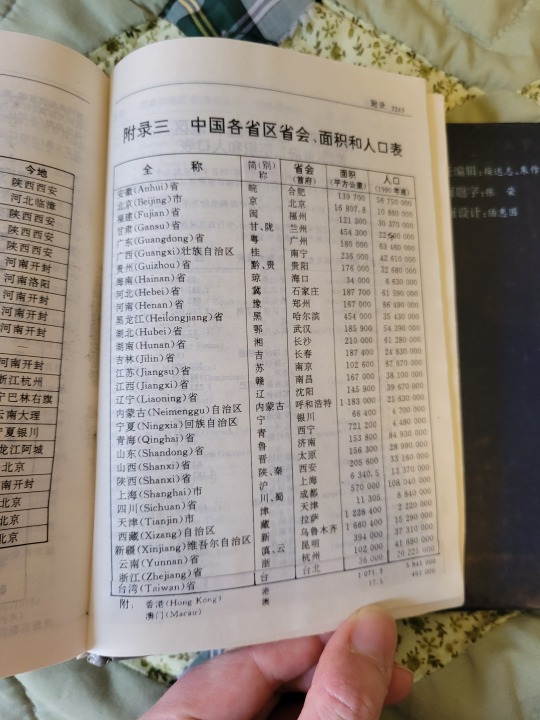
I picked up this chunky guy from a used bookstore down the street from me (the owner of the store passed last year, and the store is no longer there unfortunately). This is a fairly normal dictionary, it's just bigger than my others and has more words listed in it.
One thing I also noticed is that this chart towards the end of the dictionary apparently had a strip of paper pasted on the bottom. It doesn't seem like something I can peel up without damaging the paper under it, and when I shine a flashlight through the page I can't make out any major differences between what's on the sticker and what might be on the page under it. So my best guess is there might have been some damage to the text on the page?
5. 商务馆学汉语近义词词典 The Commercial Press Guide to Chinese Synonyms
monolingual
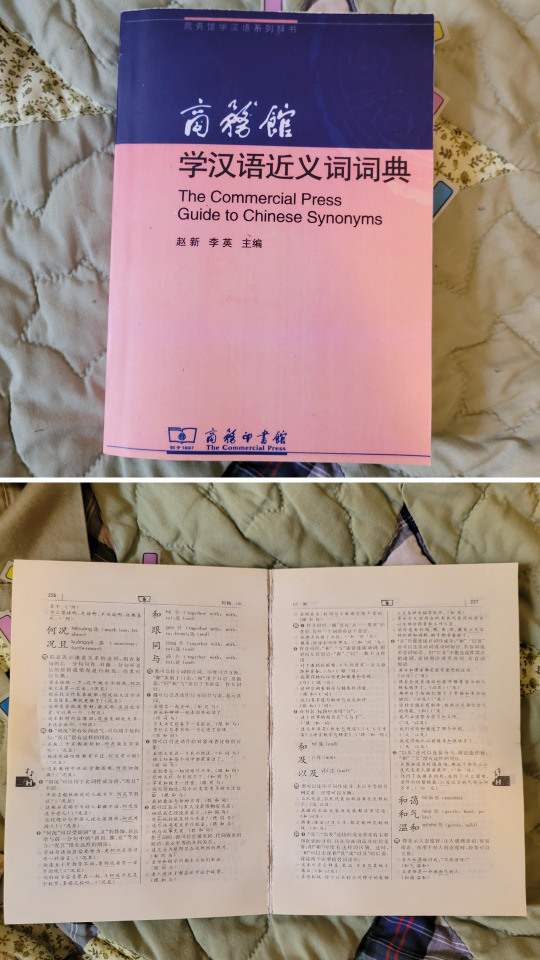
This book is easily the one I reference the most. As the name suggests, the book is all about synonyms. It takes sets of 2+ similar words and thoroughly explains the similarities and differences between them all. There's plenty example sentences, with notes about whether the synonyms can be used interchangeably in certain contexts.
It's a great resource, but I had a bit of trouble getting my hands on a copy. It's possible that in the years since I bought it there have been more copies made available for sale though.
these next two are books I haven't explored too much since they are old and the binding is incredibly fragile and starting to fall apart. just opening them is stressful.
6. 漢字分解 Chinese Characters Explained by F.X. Keelan (aka 康愛玲修女) (1967?)
bilingual
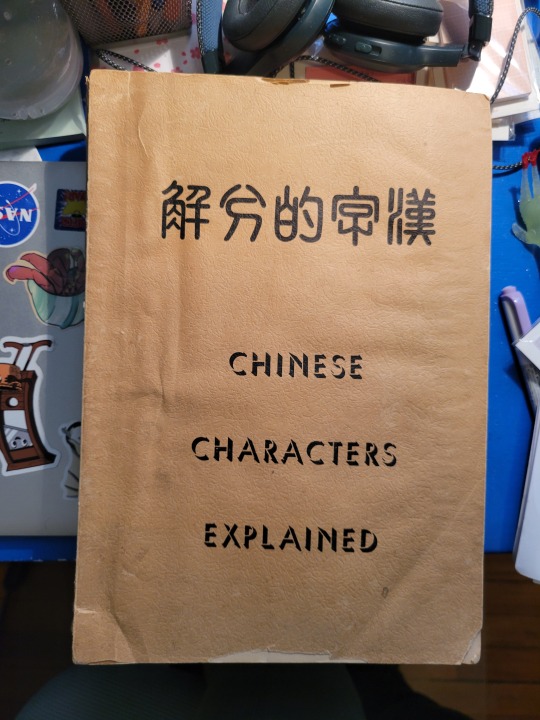


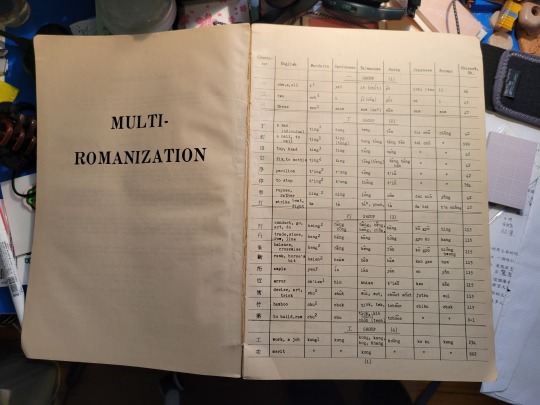


This book was also gifted to me by the nun who went to school with my grandma, and appears to also have been written by a nun! Based on what I've found from Google, this book was published in 1967.
Rather than a dictionary, this book is "a compilation intended as an aid in grouping and remembering [Chinese characters] with a view in acquiring a reading knowledge of Chinese"(p. iii). It aims to break down characters into radicals and giving similar/related characters. It's apparently the final installment in a 4 part Mandarin Course.
This book uses traditional characters. According to Google Books, the publisher is 光啓出版社, which is a Taiwanese organization. The book includes a very long table that has Mandarin, Cantonese, Taiwanese, Hakka, Japanese, and Korean pronunciations for (what seems to be) every character mentioned in the book. The intro mentions that this is so the course is more "accessible" for speakers of other East Asian languages.
Also, look at that printing error in the third photo! The text got cut off at the bottom of the page.
7. The Structure of Chinese Characters by John Chalmers (second edition, 1911)
bilingual
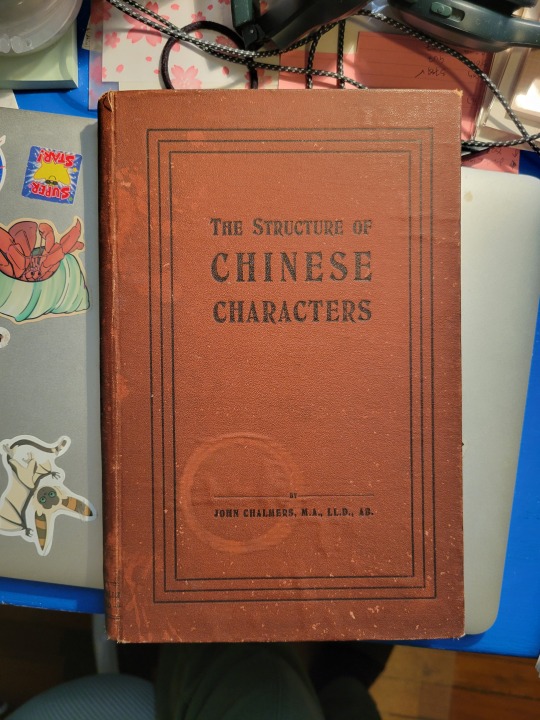
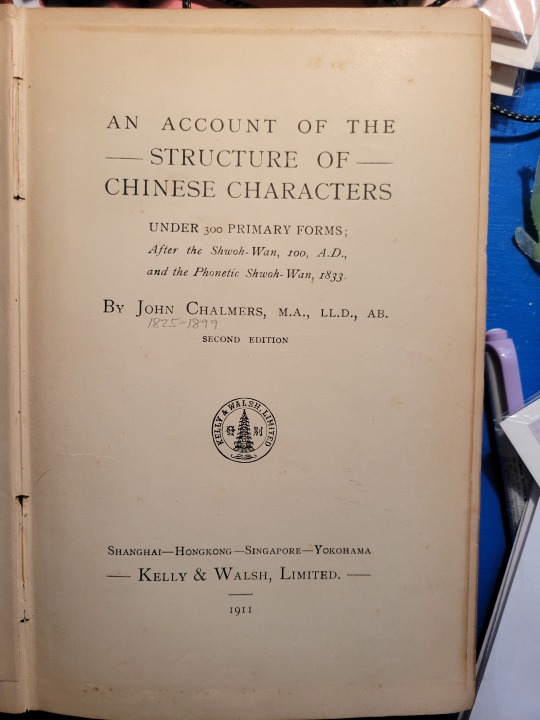
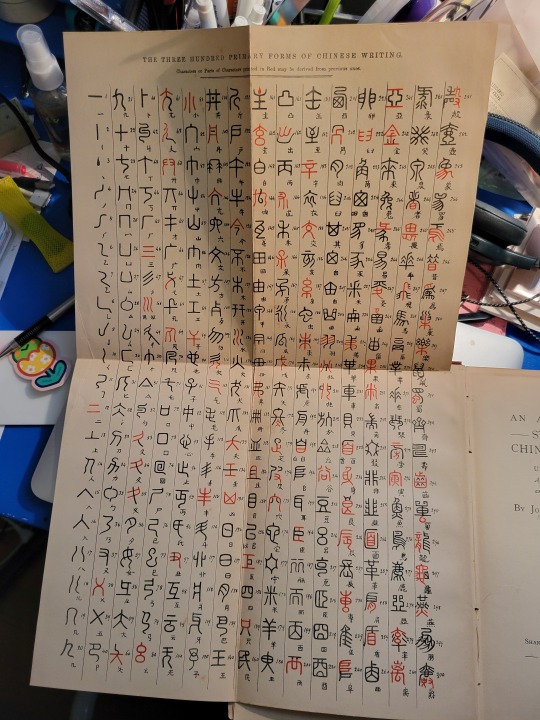

This final book is the oldest of the bunch, and was gifted to me by my boss's boss for some reason? She found it in a used bookstore apparently.
This book also uses traditional characters, because simplified characters just weren't a thing yet in 1911. This book is falling apart, and opening it stresses me out. It creaks whenever I open it.
Going by the title page, the full title of this book is An Account of the Structure of Chinese Characters Under 300 Primary Forms; After the Shwo-Wan, 100 A.D., and the Phonetic Shwoh-Wan, 1833. It was published by Kelly & Walsh, which was a Shanghai-based publisher.
Someone very kindly penciled in the years the author was alive: 1825-1899. John Chalmers was apparently a Scottish missionary (bc of course he was) who apparently popularized the term "Cantonese". This book that I own in particular was originally published in 1882.
It is, as the very long title suggests, an analysis and etymology of 300 common components
It also has a nifty fold-out of all 300 "primary forms" in seal script.
71 notes
·
View notes
Text
How to use dictionaries: A tip for language learners
tl;dr use a monolingual dictionary, and translate the definitions with deepl.
As native speakers, sometimes we take words for granted.

“Busy means busy. It's an atomic piece of meaning."

That's the mono brain talking. Often a word in one language will correspond to multiple concepts, and therefore multiple words, in another language. It should be obvious, but not all languages group their concepts into words in exactly the same way.
Even when you look in the dictionary and see multiple definitions for a single word, you can sometimes be tempted to think “But those things are the same, the dictionary writer is really splitting hairs here.”

For example, I didn’t think of the concepts of “a person having a lot of things to do” and “a place being crowded” as separate. They were the same - "busy" just means "having a lot of activity". I didn’t notice the difference until I had a moment talking in Japanese, when I tried to use the word いそがしい (often translated in English-Japanese dictionaries as “busy”) to describe a train station. The person I was talking to was completely confused. They had no idea what I was talking about. That’s because いそがしい does NOT mean “busy”. It means “having a lot of things to do and no free time” and can only refer to a person being busy, not a location.
Bilingual dictionaries are bad for this reason. They often translate a word using multiple other single words in the other language, rather than an explanation of its meaning like you would find in a monolingual dictionary. The problem with this is when the dictionary says いそがしい="Busy", they can’t strip away the extra meaning that “busy” has. In fact, I’d go so far to call the below definition incorrect.

This definition even uses the words "occupied" and "hectic" which can also both be used to describe locations or situations. I don't think these bilingual dictionaries deserve to be called dictionaries. They're much closer to being bilingual thesauruses.
People often recommend using monolingual dictionaries from your target language instead. Unfortunately, this is not very helpful for beginners, and beginners are the ones most affected by this issue. Without a critical mass of vocab and a decent understanding of grammar, you won't be able to understand the dictionary definition at all.
What we really need is a true bilingual dictionary. It would have a word in one language, and a full sentence definition written in the other language. Such a thing doesn't seem to exist. However, you can kind of make one yourself!
Here's my tip:
Use a big scary monolingual dictionary (like weblio.jp for japanese) and copy and paste the definitions into DeepL.


Like so! (I deleted the example sentences because this dictionary formats them in an annoying way, and to focus on the definitions themselves). This results in a much clearer understanding of what the word actually means, compared with using the japanese-to-english dictionary. I hope this technique helps!
#japanese#language learning#language acquisition#japanese language#language learning tip#learn japanese#learning japanese#langblr#linguistics#learning languages#jimmy blogthong
128 notes
·
View notes
Note
In your experience, how hard is to learn Na'vi?
It very much depends on the person. For myself...well, I wouldn't say it's easy per se--learning any new language is a challenge--but it's really not that bad. Compared to natural languages which are of course much more complex, Na'vi is fairly straightforward.
One advantage I have personally is having studied a bit of Japanese in the past. One thing that some monolingual folks don't always realize is that translating isn't as simple as taking a dictionary and substituting each word one by one--different languages have fundamentally different grammar structures.
Na'vi has a few grammar structures that are very foreign to English but familiar to Japanese. For example, limited free word order and marking parts of speech. English relies on word order to make who's doing what in a sentence. Hence, "I eat pizza" makes sense, but "pizza eat I" doesn't.
In both Japanese and Na'vi, however, there are grammatical bits that explicitly mark the role each noun plays in a sentence, and therefore frees up your word order. Japanese does this with particles while Na'vi does it with case endings.
Watashi wa piza o taberu
Oel pitsati yom
(Japanese it actually a little stricter with word order than Na'vi as the verb in Japanese is always expected to go at the end whereas in Na'vi it can go anywhere, but it's the same general idea.)
Similarly, Na'vi adpositions can behave similarly to some Japanese particles:
I walk to the forest
Watashi wa mori ni aruku
Oe na'rìngne tìran
Though again, Na'vi is a little more flexible in that the adposition can go before or after its relative noun ("ne na'rìng" and "na'rìngne" are equally acceptable).
Na'vi can also utilize a topic-comment structure; it doesn't do so nearly as often as Japanese does but it does exist and can be little weird for English-only speakers to wrap their heads around at first.
Of course, all that rambling aside Na'vi grammar as a whole is still very different from Japanese grammar as a whole and the two languages have plenty of stuff that set them apart--I just want to illustrate how studying Japanese in the past made it easier for me personally to grasp some of the less-Englishy aspects of Na'vi than it would've been otherwise.
And that's true of languages in general tbh; the more of them you learn the easier it becomes to pick up new ones.
That said, while having prior language experience is certainly helpful in learning Na'vi (or any language), don't let not having any stop you from giving it a go if you want! As I mentioned at the beginning, compared to natural languages it's really not so bad even without prior experience; we've got lots of learners who do well even if it's their first new language :)
#lì'fya lena'vi#hoohoohoooooo boy my japanese is rustyyyyyyy o_o;#was never anywhere close to fluent to begin with; just took some classes in college and that was a fair few years ago now#i am definitely more confident in na'vi than I ever was in japanese ^^;#but oh well w/e gets the point across i guess ¯\_(ツ)_/¯#sorry for the rambly ramble
63 notes
·
View notes
Text
Life of Q update number three or something
Finished two books: 美しい距離 and Tom est Mort.
美しい距離って、悪くなかった。それしか意見はない。無論悲しかったがいいメッセージだと思う。一方必ずあまりインサイトはなかった
Tom est mort, heum. Pas mal non plus. Le personnage principal m'a fait chier un peu, je l'avoue. Elle n'est pas une personne parfaite, loin de ça. Mais c'était << réel >>, et je respecte cette sorte de but-là. En général, le style de Darrieussecq est pas mon truc, je crois.
A few things I bought on impulse: a Cambodian dictionary, a Turkish dictionary, a book in Dutch the name of which I can't even tell you because I don't know it, a Burmese translation of Steinbeck, and a Portugese dictionary.
The weather's getting less and less pleasant. It's just soggy.
Been hanging out with my friends *explosion*
Studying A LOT. The autism is getting too strong I fear. I had to make a weekly planner of what languages I was gonna study on which days that weren't in my degree. One per day except for Mondays.
My Spanish dictionary is my first ever monolingual dico not in English!
17 notes
·
View notes
Note
oh sweet you're Romanian? the professor I do research with is from Romania and his family moved to the US when he was a teenager. when I first told my sister and dad about starting research with him, their first questions were "does he speak english well" and "does he sound like voldemort" (she forgot the name of dracula) :/
regardless, I do enjoy hearing the stories the professor tells us about his childhood in Romania. I feel bad though since he sort of plays it off as a joke whenever people don't quite understand the word he uses or his phrasing for something is a bit off. it's mostly the monolinguals who get the most annoyed and I want to shake them because English isn't easy!!!! we're lucky most things are in English!!!!
I mean... oof, that reaction is pretty much universal, although I bet I'd be a little annoyed in his shoes.
I say it's universal because... Well, as I've mentioned before, there's a sizable Hungarian minority in Romania - what I didn't mention is that it isn't evenly distributed. If you look at the map of the country, it kind of resembles a fish - Hungarians mostly live in its flipper.
...Hang on, it just occurred to me that ethnic maps exist.
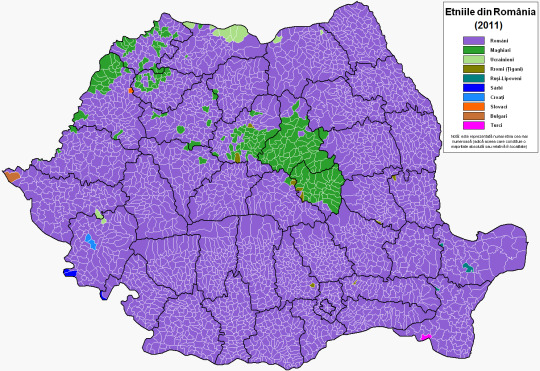
Purple areas are mostly Romanian, green areas are mostly Hungarians. You'll notice there's some green at the "head" of the fish - that's near the border with Hungary - but the flipper, that's the big one.
The flipper area is quite interesting, because what would otherwise be considered the majority population (Romanians) becomes the minority population. You have villages, towns, even small cities where most people are Hungarian. So you'll naturally have Hungarians who don't use Romanian every day (or every week, or every month...).
When speaking Romanian, of course some of them will have Hungarian accents. Of course some of them will use genders wrong (Hungarian is like English: nouns don't have gender; Romanian is like French: they do). Of course they might pick the wrong synonym (they'll say they "consume" an apple, for example).
You'd think that Romanians from majority areas, who have often learned English as a second language, who might have had the experience of not being very fluent in it, would be more understanding towards Hungarians. Alas, I've heard my fair share of Romanians from non-flipper areas being huffy and annoyed and going on and on about how it's "necessary" for Hungarians to speak perfect Romanian, but "absurd" for Romanian to be taught as a second language in schools.
The most vocal group of the sort seems to be based in the dorsal fin - near the Black Sea (alas, the Sea isn't represented on this map). Probably because they've rarely met Hungarians.
I think the problem is a lack of immersion. Until you go somewhere and need a language, but can't speak it (or can barely speak it), it doesn't really click that a language barrier isn't something you can solve with oodles of motivation and a couple of days with a dictionary.
7 notes
·
View notes
Note
Can you recommend a good beginner’s (or indeed, advanced) bidirectional Norwegian-English dictionary? Preferably an ebook or app? Takk!
Hi there! Honestly I don't think I can be much help here; I use a combination of ordbokene.no (monolingual Norwegian), Google Translate and help from native speakers. I've never used an app or an ebook. The only bidirectional dictionaries I've ever used are paperback ones. I have Hippocrene Norwegian-English/ English-Norwegian Practical Dictionary which I find super useful for translating to and from Norwegian bokmål. The other one I have is Norwegian-English Dictionary by Einar Haugen. It doesn't have English-Norwegian, but it has nynorsk as well as bokmål, plus older words and dialect words.
Sorry I can't really help more :( But maybe my followers can suggest things?
18 notes
·
View notes
Text
200 Hour Polish Update
*Caveat: I had been studying Polish since around 2020 using mostly traditional methods. If you look, I’ve been in this server for a while so I, in my infinite stupidity, was lazy and didn’t start doing a lot of immersion until this year (despite being pretty obsessed with learning Polish… ik weird ass logic). Which so far, has been 200 hours. Realistically, I don’t know how many hours my total progress indicates but ehh. Before this year my study has mostly just been reading about grammar and reading from textbooks.
What has my immersion consisted of?
watching videos on YouTube (without subs)
listening to podcasts
How much a day / how do I track?
200 minutes a day (3.3 hrs). At the start I did 60 minutes (1 hr), and then I moved up to 100 minutes (1.6 hrs)
I track everything with a pen and small notebook. I think it’s more satisfying (and easier for me) to track this way. It boosted my motivation to see pages fill up. I much prefer physical tracking to digital. Personal preference, this is neither good nor efficient so don’t do this lol.
What I’m glad I did / progress I made.
I started off this year already with a decent level. I could understand basic conversations but sometimes I would have a hard time catching words I knew just because I hardly did any listening. 200 hrs later, I have no trouble at all with that. I can follow more complex lines of thought and discussions. I will say though, I still struggle with stories. I think if I focus on that type of media that will sort itself out. My main focus was just to get good at the subjects I enjoy. I don’t like TV / Movies / fiction at all, so I mostly avoided it. I started off the year with watching My Life as a Teenage Robot, Hilda, and a little Kid Cosmic (never finished it) but I didn’t really want to continue that since I was getting bored. Once I switched to videos and podcasts about subjects I enjoy (history, religion, politics) I found it much easier to go on for long periods of time.
I now find it much easier to write / think in Polish. My writing is not that great still, but I feel like I’ve made progress. I plan to focus on output more in the future, but I think that I will focus on improving my writing after I start reading more. I need to see good examples of the written word before making serious attempts to replicate it.
I did no look ups (with some exceptions but for the most part it was exceedingly rare, and when I did it was monolingual). I’m glad I made that choice. Before one of my main barriers to immersion was all of the Anki fiddling and sentence mining / look ups. I am someone who has a hard time getting in the habit of doing things, and a lot of that was a huge barrier to entry for me. I said screw it, and just sat down and watched stuff. Nothing more, nothing less. I think this is one of the best choices I’ve ever made. Besides the executive function matter, I think overall this was more beneficial than If I had managed to do Anki and look ups. I know myself, I would’ve poured over the nuances of a certain word out of context in a dictionary entry. Which in the grand scheme of things, is a massive waste of time. That time is much better spent engaging with content. The word’s I’m „ready to learn” will come to me so to speak. I strongly recommend this strategy. It’s a little uncomfortable at first, but in the long run it’s worth it.
What do I regret?
Not starting sooner (duh). Seriously though, the main lesson I Learned was to not be so slow to change. I am a very change resistant person, I really struggle to change my routine / try something different. This really has shown me that just getting started is very very worth it. Even if the first few days suck.
Trying to read books too early. I don’t know why I tried to do this. I don’t particularly enjoy reading in English, so I’m not sure why I tried to force myself to read in Polish, which is obviously harder. My reading era in Polish shall come someday, but I’m not going to try it until I can get into it in English first. If It’s a chore to do I won’t bother with it right now. One of my goals is to read Sienkiewicz but that’s a far off goal. I will let you all know when I get there.
Previous and current level (self assessed, take with a grain of salt)
2C/3 in refold terms (current)
Level of Understanding (before) A2-B1
Level of Output (before) terrible, I shudder at the thought
Level of Understanding (current) B2
Level of Output (current) B1, needs work of course…
Statistics
Start: Sat. Jan 7th
End: Tue. Apr 11th
Jan: 2061 min / 34.4 hrs
Feb: 2149 min / 35.9 hrs
Mar: 5220 min / 87 hrs
Apr: 2459 min / 41 hrs
What now?
I am going to take a temporary break from Polish to focus on Czech. I will be moving to Prague in the fall so I want to get a bit of a head start (even though I will be learning Czech there anyway as part of my degree program but I plan to use English as little as possible when I get there.) I want to do about 100 hours in Czech and then return to Polish (rather, incorporate both into my routine). Partly because I want to get through the beginner stages of Czech as quickly as possible (with minimal Polish interference) and partly because I want to see how my Polish will fair after a break. Will it improve? Get worse? Stay the same? Remains to be seen. I will provide an update after I do said 100 hours in Czech. The nature of that update again, remains to be seen.
A few words of likely generic advice...
Don’t be hard on yourself. I know this is almost a cliché at this point, but being overly critical of myself stunted my progress. I was afraid to challenge myself out of fear that I was not ready / I wasn’t good enough.
Don’t try to optimize everything. It’s impossible. You wont be able to keep perfect records of everything, you wont be able to track every second, you won’t be able to exactly know where you’re at level wise. It doesn’t matter where you are right now, just keep moving forward. Even if you aren’t that far now, if you keep moving you’ll be a lot further along than if you hadn’t moved at all.
Dziękuję serdecznie za uwagę! Czołem ;-)

5 notes
·
View notes
Text
A Glossary for TESOL Terms
EFL? SLA? TESOL? ACTFL? L1? C1? OMGWTFBBQ???
TESOL (Teaching English to Speakers of Other Languages) is a field that is absolutely full of impenetrable jargon. Sometimes the jargon is so bad that common acronyms can mean different things across various sub-fields or at different points in time. Terms also come in and out of vogue, as per usual with fields connected to activism and minority groups – when the groups you are discussing, such as immigrants, are denigrated, then descriptive terms can become pejoratives, so new terms are created, and then those too become pejorative, and on and on until the group is no longer seen in that negative light, so that new terms aren’t tainted by association. Be prepared to encounter many terms in this list for the same groups of people, especially for people learning English in English-majority contexts.
This is not a dictionary; I am not a lexicographer. These descriptions will have pretty overt biases (for example, I hate the euphemistic implications of the new MLL (Multilingual Learner) phrasing). Disagree? Drop me an ask, submit a diatribe, or otherwise HMU (Hit Me Up).
General Categories:
Words for Learners
Bilingual – A person who speaks two languages, or a person who speaks more than one language. Doesn’t specify proficiency, though can sometimes imply that both languages were acquired in early childhood (sometimes “simultaneous bilingual”). Suffers from the same fight as “bisexual” re: bi- meaning specifically two or simply more than one.
EAL – English as an Additional Language. This phrase is often used for professionals who use English for specific purposes (ESP) related to their work, but do not use it in other contexts. I’ve often encountered it referring to academics who publish in English but do not use English outside of academia.
EB – Emergent Bilinguals. This phrasing is growing in popularity (according to my cursory Corpus research). It has the same issues as “Bilingual” above, with the added benefit that if a student is already bilingual before beginning to learn English, they aren’t Emergent Bilinguals, they’re just bilinguals who are now learning English. Also: the majority of students in the US take a second language course before they graduate. Are they emergent bilinguals? Why not? They are learning a new language. This euphemistic labeling obscures the services and support that students need. (My stances on disability advocacy may be bleeding over here.)
EL – English Learner OR English Language. Older term, and the ambiguity out of context doesn’t help.
ELL – English Language Learner. A person who is learning English. Sometimes problematic for second-language speakers who are past the “learner” stage.
ENL – English as a New Language. Some learners who do not progress rapidly in their English Language development still require support, even though English is no longer “new”. Has fallen out of favor.
L1 – First language. Usually the language or languages learned at home during early childhood (i.e., before 4 years old).
L2 – Second language, any language learned after the L1. When unspecified, and in a learning context, is somewhat synonymous with “Target Language”.
MLL – Multilingual Learner. Like EB above, this phrasing is inherently ambiguous and obscures the needs of language learners. A student whose home language is English and who has studied Chinese and is having trouble in Chemistry is a multilingual learner – does she receive support and resources for MLLs? It at least gets rid of the “bi means two” element.
Monolingual – someone who only speaks one language. Proficiency is assumed to be advanced or “native-like”, though this is a somewhat ableist supposition.
Multilingual – someone who speaks more than one language. Does not specify proficiency levels or literacy in the languages.
NNS – Non-Native Speaker. This phrasing fell out of favor in the 90s and early 2000s.
NS – Native Speaker. This phrasing fell out of favor in the 90s and early 2000s. Modern approaches to English such as ELF and WE (below) try to de-center “native” proficiency in English as the pinnacle of language use.
Words for Teachers
CELTA – A Cambridge English certificate for teaching ESL. The acronym used to stand for “Certificate in English Language Teaching to Adults” and now “stands for” “Cambridge English Level 5 Certificate In Teaching English to Speakers of Other Languages”, which very much does not start with the letters CELTA. This is a well-regarded certificate program, which in many EFL contexts provides the same qualification as a master’s degree in terms of teaching placements.
COP, CofP – Community of Practice. CofP is the preferred term in sociolinguistics research, COP in teaching. (Not associated with the police, ACAB, etc.) A group of professionals in the same field and context that can work together in PD and generally support each other with specific problems in practice.
EAP – English for Academic Purposes. Courses or lessons in the use of Academic English. I currently work in an EAP Program at a university that prepares students for the academic requirements of an American university. The acronym is also used in K-12 contexts for lessons on academic speech and writing.
EFL – English as a Foreign Language. English taught in places where the main language outside of the classroom isn’t English. This means that students don’t always get exposure to English in their daily life, but it also means that their proficiency in English will not jeopardize their safety. This is the kind of English teaching I prefer – my students may or may not have a pressing need to learn English quickly, but their ability to survive daily life is not resting upon my shoulders. There’s more room for language play and low-stakes exploration.
ESL – English as a Second Language. In context, this means English learning in places were English is the main language outside of the classroom. ESL students get exposure to English all day every day, and they need to be able to survive, find a job, secure housing, etc.
ESP – English for Specific Purposes. English language courses that focus on specific content areas. Can be broad (e.g., EAP is a form of ESP) or narrow (English for textile manufacturing). Niche markets can allow ESP instructors to charge extra money for their expertise; ESP is also enjoyable for teachers who like to learn about and study different content areas.
Four Skills – Reading, Writing, Speaking, Listening. Long ago, the four nations lived together in harmony . . . The main skills that are taught in language classrooms (along with grammar, vocabulary, and functional language). There are two oral skills (Listening, Speaking) and two written skills (Reading, Writing). There are also two Receptive skills (Listening, Reading) and two Productive skills (Writing, Speaking).
Home Language – The language or languages that are spoken in the home or by the parents or guardians of a person when they are/were young. This phrasing has replaced “native language” in a lot of contexts. Even in EFL, it’s useful to distinguish between a home language and a local language, as there may be many languages spoken in any given community.
IEP – Intensive English Program OR Individualized Education Plan. An Intensive English Program condenses the multi-year language-learning journey into a much shorter timespan by requiring many hours per week of in-depth language study. The EAP Program I teach in is an IEP. In US K-12 contexts, an Individualized Learning Plan is used for students who have support needs beyond those of the average learner in a classroom – ELLs and students with disabilities are two common groups of students with IEPs.
K-12 – USAmerican term for kindergarten (5-6 years old) through the final year of schooling (12th grade, usually 17-18 years old). I believe that all children in the US are guaranteed access to free, public K-12 schooling, though I may be incorrect on that. K-12 context refers to school-age learners. Some school systems offer Pre-K (preschool or Head Start) and are labeled Pre-K-12.
MA – Master of Arts, a university degree usually obtained after a bachelor’s degree and either in place of, concurrently with, or before a PhD.
PD – Professional Development. Workshops, Reading Circles, Communities of Practice, and other ways to continue learning about the field while working. I’m the kind of nerd that absolutely fucking loves PD events. Shocking, I know.
SLO – Student Learning Outcomes. What the students should be able to do by the end of the course. These should guide curriculum, syllabus design, and lesson planning.
TA – Teacher’s Assistant. Helps a teacher or professor in the classroom.
TEFL – Teaching English as a Foreign Language. My first teaching certificate was a TEFL Certificate. It’s also the term for the field of Teaching EFL in general.
TESOL (1) – Teaching English to Speakers of Other Languages. The field of English Language Teaching (as opposed to English Language Arts or English Literature). TESOL (the organization, below) offers a Certificate under this name.
TL – Target Language. Can be used for the language as a whole (when I’m teaching, the TL is English; when I’m using Duolingo, the TL is Chinese) (I absolutely just pulled out Duolingo to extend my streak)), or can be used for the specific language item you’re currently teaching (in a grammar lesson, the TL may be something like “irregular past”).
Words for Organizations or other Groups
AAAL – American Association for Applied Linguistics. An organization that puts on a yearly conference about Applied Linguistics. (See my presentation on the conference for more information.)
ACTFL (1) – American Council on the Teaching of Foreign Languages, though they don’t really use that acronym anymore. The organization focuses on teaching non-English second languages in the US, so they as a whole are less relevant to TESOL, but 1) as an EFL teacher, they technically teach in the same context as I did/will, and 2) their proficiency guidelines are very useful, with much more transparent naming conventions and descriptors than the other systems like CEFR or WIDA.
IATEFL – International Association of Teachers of English as a Foreign Language, a large European organization that holds an annual conference. The organization is old and well-respected in the field.
TESOL (2) – TESOL International Organization, which no longer uses the acronym Teaching English to Speakers of Other Languages. The biggest organization in the field, they hold an annual in-person conference and publish two major academic journals, TESOL Quarterly and TESOL Journal. (See my presentation on them for more information)
Words used in Research
AntConc – A computer program made by Lawrence Anthony, which aids in Corpus Linguistics research using user-generated corpora.
APA – American Psychological Association. Their Style Guide is used for citation by most publications in the fields of TESOL, Applied Linguistics, and SLA.
Applied Linguistics: The area of linguistics focused on language learning and language teaching. Very related to Second Language Acquisition, in the same way that Sociolinguistics and Linguistic Anthropology are very related but technically still distinct.
CALL: Computer-Assisted Language Learning. Any language learning programs done over computer, including, for example, distance learning over Zoom, vocabulary learning with Quizlet, or learning a language on Duolingo.
Corpus Linguistics – A field of linguistics that studies large data sets to find statistical information about linguistic phenomena. Prior to the computer era, it was difficult to describe how language was used beyond the instincts of speakers. Corpus linguistics allows researchers to find information about naturalistic language use.
DI – Differentiated Instruction. Teachers can change the kinds of instruction that students received, based on their needs, interests, goals, etc.
ELF – English as a Lingua Franca. A theoretical framework that sees English as the common language of certain international fields, such as aviation and research publication. ELF research highlights the fact that much of the English spoken today is between groups of people who do not use English in their daily lives but need a shared language in order to communicate.
Indo-European – A family of languages that includes most of the languages of Europe and Northern India. These languages share a common ancestor and tend to share cognates.
LLM – Large Language Model. Generative AI chat programs such as ChatGPT use large corpora in order to statistically predict (with great accuracy) an acceptable subsequent word in a string. These LLMs are frequently anthropomorphized as having sapient, human-like capabilities of reason, knowledge, and evaluative or analytical abilities. Do not be fooled. They are advanced predictive text or autofill.
SLA – Second Language Acquisition. This is the field of study focused on learning a language after early childhood.
SLW – Second Language Writing. The specific field of teaching productive literary practices to, or studying the work of, people who learned a language after early childhood.
UG – Universal Grammar. A bogus theory by Noam Chomsky that in linguistics has been thoroughly debunked for decades now. Realizing that SLA still believes in UG was like being in undergrad Gender Studies classes and realizing that people were still using Freud and Jung. It’s horrifying.
WE – World Englishes. (Note the plural). A framework that conceives of English as being a world language with many local variants. The praxis of the theory focuses on decentering the “Inner Circle” Englishes from the US, UK, Australia, etc. and thoughtfully studying the Englishes in Outer and Expanding Circle countries.
Xenolinguistics – The (currently hypothetical) field of linguistics that studies non-human non-Terran languages. As we have not yet had a first-contact incident with sentient extraterrestrial life, this field mostly looks at questioning the underlying suppositions of what language fundamentally is – which concepts of language are inherent to communication and which are anthropocentric? Xenolinguistic ideas can inform conlang (constructed language) creation – sci fi and fantasy languages such as Sindarin, Dothraki, Klingon, and Na’vi need not be bound by modern human limitations.
Frameworks, Standards, and Associated Terminology
ACTFL (2) – ACTFL Proficiency Guidelines have 11 levels. The lower 9 levels are divided into sub-levels of “low”, “mid”, and “high”, while the last two are not divided. The first three levels are “novice” – novice-low, novice-mid, and novice-high. The next three are “intermediate” – intermediate-low, intermediate-mid, and intermediate-high. The next three are “advanced” – advanced-low, advanced-mid, and advanced-high. The highest two levels are Superior and Distinguished. The system assesses the four skills and focuses on communicative competence. My favorite part about this system is how transparent the level descriptors are – even lay people can get a good idea of someone’s language proficiency if they hear “intermediate-low”, for example.
CEFR (A1, A2, B1, B2, C1, C2) – Common European Frameworks of Reference. These are the language proficiency levels created by the Council of Europe and used by the EU. This proficiency framework is the most well-known internationally, even outside of Europe. The terminology is a bit more opaque than the ACTFL’s, but the descriptions of the proficiency standards are much more detailed. The higher levels require not only communicative competence but also advanced critical thinking skills and translation abilities, locking some L1 language-users out of the highest CEFR levels.
CLIL – Content and Language Integrated Learning. The European system of teaching grade-level content to L2 learners.
CLT – Communicative Language Teaching. The current favored language teaching methodology across most of the world. CLT highlights that language is a tool to achieve the goal of communication, and as such focuses on using form to share meaning instead of focusing on specific grammar forms or memorized vocabulary out of context.
IELTS – International English Language Testing System. An English-Language proficiency test from the British Council and Cambridge. This test is very popular internationally, especially as it is one of the only proficiency tests accepted by immigration authorities in the UK, Australia, and Canada (which have language proficiency standards for getting work and student visas??? I’m American, so having a language requirement for immigration is literally foreign to me.)
SIOP – Sheltered Instruction Observation Protocol. A methodology for teaching grade-level content to language learners that emphasizes content comprehension alongside language development. The full SIOP program is very intense and full of a million rules, but sheltered instruction as a general term refers to the content and language dual focus (similar to CLIL, above).
TELPAS – Texas English Language Proficiency Assessment System. This is the Texan version of WIDA (below). It is an assessment for all students in Texas whose families have a home language other than English, and is the foundation of their EB programs in the state.
TOEFL – Test of English as a Foreign Language. This is a US language proficiency test for international students who want to study in US universities. It is also accepted in the US and abroad for some other uses, such as job applications or, again, visas to countries that require English language proficiency.
WIDA – the WIDA Consortium (previously World-Class Instructional Design and Assessment) is a group that creates and maintains language proficiency standards for the majority of US states and many other countries and regions. It is primarily K-12 and content-area focused. It promotes the term multilingual learner, which is a mark against it IMO.
Misc Other Terms
[Language] Center (English Center, Spanish Center) – A language center is an educational facility that focuses only on the teaching of one language. Students can range in age from pre-kindergarten to adults, though some language centers focus on specific demographics. A famous international English Center company is Wall Street English, which has locations all over the world and focuses on classes for adult professional EAL speakers.
ACAB – All Cops Are Bastards.
ASL – American Sign Language
IMO – in my opinion.
LESCO – Lengua de Signos Costarricense = Costa Rican Sign Language
OMGWTFBBQ – an old internet saying from a time before “social media”, used to highlight the plethora of acronyms that exploded in the late nineties and early aughts.
0 notes
Text
Synonym for monolingual

#Synonym for monolingual full#
Greek, all of the first paragraph and each following paragraph up to the end of the first quoted exampleĨ.Latin, all of the first paragraph, each paragraph giving the definitions, and the first quote for each numbered definition.A rule for how much of the D-L to translate. I propose using the core vocabulary lists from Dickinson college. The D-L dictionary has too many entries to start from.
#Synonym for monolingual full#
where the D-L abbreviates, copy that except when they are abbreviations of names of authors, reference sources, languages etc but otherwise unabbreviate the word (so if the D-L refers to a reference from Terence as Ter., copy that, but if they prefer to prosody as Pros., translate that into the full unabbreviated term)Ħ.
in Greek, use polytonic characters (and no combining characters) and use iota adscript rather than subscript.
don’t use smallcaps (in case this does not work on some systems).
put an empty line between each paragraph.
don’t use tab for new paragraphs: left align on the same margin all text, and don’t use tab or more than single spacing anywhere within an entry.
đ2pt Times New Roman for the quotes part.
đ4pt Times New Roman for all parts of the dictionary entry other than the quotes part.
I propose copying the D-L dictionary for that language A dictionary entry format, and spelling conventions, to copy. I propose the Cambridge English Dictionary online: ģ. For Greek I propose LSJ 9th edition including supplement, here. The most authoritative dead to living (D-L) dictionary. The aim is to produce a dead to dead (D-D) dictionary. if not, it probably proves that even if theoretically possible the work invested in it seems less productive than continuing to slog through texts. i'd be willing to work on it here and there with others if there was any interest. i was thinking about this today and came up with the following. i have no view personally on whether this is ultimately going to be useful (because as i said earlier the one thing i've always wanted to see is research on whether immersion in a dead language activates some language learning part of the brain not activated by bilingual materials) but this doesn't mean i can't visualise how the work product might turn out. Hi all, i think ultimately the proof of whether this exercise of working on a monolingual dictionary could be useful is actually (a) looking at how it might look concretely and (b) seeing whether there is any appetite to produce one.

0 notes
Text
How To Learn A New Language At Home

Learning a new language is more important than you ever thought. In this article, I am going to show you how you can learn a new language on your own at home. So read and enjoy!
The Four Skills of Any Language
Learning languages is getting easier than ever before. There are four skills you have to master if you want to learn whatever language you want. The four skills are:
1. Reading Skills
Reading is the most important aspect of learning languages. If you want to start learning a new language, you have to figure out what to read. As a beginner, you should read something simple such as kids' stories or Graded Readers. Either of them is good to start learning a language: they are written with simplified language that is easy to understand and they can build your vocabulary. Try to read and don't bother yourself to look up each word. All you need is to focus on the keywords (a keyword is a word that represents the main feature or idea of something). Try to use at first any translator app/website to look up words until you have good vocabulary knowledge then try to use something advanced like a monolingual dictionary.
2. Speaking Skills
When you start to learn any new language, you have to speak it. Sometimes it would be very difficult to find someone to practice your new language speaking skills with because maybe you live in a country where there are no speakers of it. I have these two solutions:
Making Friends On Social Media
My best way to practice speaking is to make friends on social media. I have a lot of friends on social media who are willing to speak with me to practice my second language speaking skills every day.
Exchange Languages Apps/Websites
My favorite solution ever! There are so many apps and websites where there are people who want to learn your language and are willing to help you to learn their languages. You can help them to learn your language and they will do the same thing. You can find those apps or websites on the internet they are called Exchange Languages apps/websites.
3. Listening Skills
Listening skills are important as the previous skills and to improve your listening skills there are two resources that I prefer:
1. YouTube
On YouTube, you can watch movies, video games, animations, and vloggers to improve your new language listening skills.
2. Podcasts
One of the best tools to help you to improve your listening skills. Podcasts talk about so many topics. you can download them, and listen to them wherever you go on your smartphone or in your car.
4. Writing Skills
Writing skills is as important as all the skills that I have mentioned above, and it can be improved by writing every day. I write journals every day or participate in social media posts. When I write journals, I share them on any Exchange Languages platform to get feedback on my writings, and I noticed my writing skills are getting better than ever before in my second language.
Conclusion: Learning languages requires so much patience and focusing on the four skills of the language: writing, speaking, reading, and listening. When you practice them every day, you'll notice progress in your language.
Note: English is my Second Language, so sorry if you found any grammar mistakes!
#reading#books#education#fiction#writing#english writing#language#writers on tumblr#journal#journaling#Content writing#blogging#english learning#learningenglish#learning languages
73 notes
·
View notes
Note
This isn't a question about intelligence of characters (I hate those discussions) but if we consider in character stats (in HTR13) by "intelligence" it actually meant "knowledge" what kind of knowledge does it referring to?
I've seen people discussing this and one of their assumptions was that the word knowledge is referring to characters knowledge about death note and shinigami. Which I don't think it makes sense because a character like Misa (who was second kira) has a lower stat than characters like Ray Penber (who had no idea what the death note was). Also surviving Task Force members should have more stat.
Other than that it might mean academic knowledge. But then characters like L, Near, Mello and Matt who grew up in wammy house and probably had very high quality education get to be in the same range to characters like Light, Mikami, Takada, Ray, Naomi (and etc.) who had normal educations.
Do you have any thoughts on this? Or what knowledge means in this context?
I've looked into it a bit ago and in the end, the answer I've reached is that is that the multiple pro translators who have arrived at 'intelligence' as their way of interpreting it had a good reason.
HTR13 translation isn't always good, but with monolingual dictionaries giving explanations like 'the ability to know and understand something'... I feel like it works out alright as a way of putting it in English.
Jisho also lists "知識人" (the same term + kanji for person) as 'an intellectual', which further supports the idea of this meaning something that is both having knowledge and being able to put it to good use rather than just learning things by heart.
8 notes
·
View notes
Text
how i (currently) use anki
Hi everyone! I am looking for ways to switch up my Anki usage for languages and school subjects, but I thought I'd go through how I currently use it so I can have a comparison point later on and so others can get ideas. So here's how the process goes from farm to table when I make cards for my Spanish deck. (@in--other--words this is for you!)
Step one: Find sentences from books and news articles with new vocab words OR find words from everyday life. This is the very beginning of the process
Step two: For each card I create, I need at minimum three fields: the vocab word or phrase, the definition of the word, and at least one example sentence. I fill in the missing definitions using the RAE's dictionary or AsíHablamos if it's a slang term, and then I get example sentences from SpanishDict or Linguee. As a rule, my cards are monolingual unless I can't find a good definition for them.
Step three: I use a special note type I made with 7 fields. They are:
The field for the word or phrase
The definition, in Spanish
Synonyms of the word in Spanish
An audio field (I use the add-on Forvo DL to fill this, but I don't use it so much anymore, especially with rarer vocabulary)
Three fields for the three example sentences maximum
So, to make the cards, I have an excel sheet where I fill out each field (except audio, which is done manually in Anki on a case by case basis, if I really need the word), and when I amass about 100 new vocab words, I use the export to csv function to get a file to import to Anki.
Step four: My note type is set up to use the fields to formulate different types of cards. One card, for example, will prompt with the definition and ask for the word, while another will ask you define the word in context, and another asks you to spell the word you just heard in the audio (this is way more helpful for Portuguese than Spanish, since I have a bit harder time spelling things in Portuguese). If every field is filled out, I end up with 6 cards per vocab word. You can edit this and add a field for images, or take out any you find to be superfluous though!
Step five: During reviews, I have the setting "Bury related new cards until the next day" checked, so that all of my new cards each day are a new word and not 7 cards for the same word. Every day I do ten new words and all my reviews! The pace is pretty livable and I never feel overwhelmed by cards.
So that's pretty much it, I'm looking for ways to shake it up and make the process a bit more efficient, so I hope to update you all later with any changes I make! Something I'm considering is finding a new type of card all together, for example, including listening practice or something like that. Feel free to suggest things if you have any ideas!
13 notes
·
View notes
Note
Hi Rosie! I saw you mention that you sometimes don’t think your English is that great but I think that you are very well spoken and I wouldn’t have even guessed that it wasn’t your native language if you didn’t say so (or if I didn’t see your Spanish posts lol). If I may ask out of curiosity, when did you learn English and when did you consider yourself fluent? Did you learn it in school or elsewhere? Have you ever lived in America/the West before? I wish I could ask Namjoon/the other members questions like these because I love to hear peoples’ experiences on learning a language, especially because I’m a basic monolingual person lol.
Hi, anon! I'm honoured that you asked me the questions you wanted to ask Joon and guys about learning another language, I mean that sincerely.
You don't know how nice it felt to read that my English is good, especially because as I said, it's not my first language and I don't consider it to be good.
When I learned English... there were several ways or methods, to be honest. At school and even at university I had English classes but it was very basic, so I have never attributed what I know to that academic stage of my life.
Since I was a teenager I always liked music in English, so what I used to do was to download the lyrics of the songs I liked and the translations in Spanish. After that, as I learned the lyrics of the songs in English, I would read what they meant in Spanish so that my mind would make a connection. That way my mind got used to it or remembered the words so the next time I heard a word, I knew what it meant. Another thing that helped me, and in this, I am somewhat similar to Joon, is that I used to watch a lot of series and movies in English, with subtitles of course. The exercise there was basically the same as the one I did with songs, and it helped that I repeated a lot of the series I liked.
Lastly, and I think what helped me the most, was reading books entirely in English. And it all started thanks to the Twilight series. One day I watched the first movie and I liked it so I decided to look for the books, I remember I found the first 2 books in Spanish (illegally, I must confess) but the last one was only in English and I wanted to read the book! So I downloaded it and with an electronic dictionary by my side, I read it. After a while I found a copy translated into Spanish and downloaded it, there I did again the same thing I did with the songs and series. After that I kept downloading and buying books in English, I became obsessed with British YouTubers and little by little it became natural for me to read and understand English almost perfectly. The writing I think could be better but you understand me and that's what matters. One thing I do think I need to improve a lot is my pronunciation. Although I know what to say and how to say it, my pronunciation is slow and precarious.
I want to take classes to improve my pronunciation more than anything else, but I haven't had the time to do it.
Well, I live in America, the continent ahaahah. I live in South America.
I honestly don't consider myself fluent in English but I could make myself understood perfectly well in English if I needed to ☺️☺️☺️☺️
12 notes
·
View notes
Text

18/9/21
Finished my first 乙女ゲーム, 剣が君! I don’t really know why I waited this long before I dove into this genre of visual novels - it just makes sense for me to read something that targets a female audience. Too soon to say, but this genre really is battling for a spot next to my 少女漫画 loving heart.
This VN is definitely an excellent entry to the genre. I love this game. This is right up there with Island for me. The moment this got included in the voting list for TheMoeWay’s visual novel of the month, I was so invested in it by just reading the blurb and seeing a few screenshots. Never mind the fact that I generally enjoy historical fiction in media - I believe its called 時代劇 in Japanese - so I often actively look for and watch period dramas and read books with historical settings. This was perfectly up my alley because of that, and I really loved that aspect of the game more than anything else.
And my goodness, the CGs in this are top of the line indeed. Do you know how hard it was to narrow down to just a couple CGs for every character in this game for this post? Definitely had to be a little creative in my formatting! All the imagery in this game was so beautiful, the character sprites very detailed and so full of life and individuality, including the female protagonist. This is also the first VN I’ve played that allowed me to name the MC - a chance to self-insert in an otoge no less? Heck yes, sign me up!
This also comes with a built-in dictionary which was so helpful for understanding a lot of the 江戸時代 references - nothing that Yomichan and some good monolingual dictionaries can’t cover, but it was very useful nonetheless.
Every end in this game (four for each character, from worse to best end, aptly labelled as 荒魂-奇魂-和魂-幸魂) varies significantly from each other so it makes it worth the time it takes to read each one. Obviously, not all ends were fantastic, and there were some disappointments, and possibly some loopholes, but they were results that still made sense for the characters to do, which made most if not all routes well rounded. Honestly, this makes ranking the characters (which I will do in the spoiler section) so difficult because I like most if not all ends in this game.
The only thing I will complain about is the skip functions. The common route was incredibly long if you play for 100% completion, and I just wish that the text changed colors at least to indicate what you have read. The skip does stop on new lines which was good, but I made the mistake of using the scene skip to the next choice, which was admittedly my fault, but because I hadn’t saved I had to do all the skipping again. Other than that, this game is golden.
Verdict: 9/10 will absolutely read again, preferably when I'm less of a Yomichan cope reader. ( ´∀`) I also am eyeing the fandisk, because apparently there’s tons of new content and more CGs, maybe as a Christmas/birthday present.
STATS

Time spent reading per route: Majority of the common route: 15.51 hours; 黒羽: 9.88 hours; 縁: 10.31 hours; 螢: 10.06 hours; 左京: 9.3 hours; 鈴懸: 9.79; 九十九丸: 8.62 hours; and ご褒美 (貸本屋): 1.45 hours.
If it weren’t already so blatantly obvious how much I enjoyed reading this, I hit a few Japanese reading milestones for this game, the first one being that I managed to read 100,000 characters twice during the 18 day period I was reading. If you weren’t aware, that’s about a single volume of a light novel’s worth of reading. I also managed to read for 7.8 hours during that same session which is a first for me. Usually I give up after 2 or 3 hours of intensive reading, but I literally had to pull myself away from this one, which meant that I also read above 35,000 characters everyday (except on day 18, because the 貸本屋 part of the ご褒美 section wasn’t that too long of a read) which was my daily goal. It was also my first time reading at 16,440 characters/hour at one point, finally trumping my slightly suspicious reading speed for Island’s end game. This also meant that I’ve managed to achieve an average speed of 14,016 characters/hour for a game that’s close to or above a million characters long. In total, I read for 74.92 hours, 12.93 hours less than Island.
I’m absolutely bubbling with excitement for the prospect of finding more VNs such as this and beating whatever I achieved here once again. A tall order, maybe, but this is what makes immersion learning so worth it for me. Just reading and listening to the stuff that I like and learning not only the language, but also culture, and history, and so many other things in the process.
Please, if you haven’t read this VN but would like to, skip everything below and read it first. It’s worth experiencing for yourself.
Spoiler CGS and discussion about every route including brief thoughts on all 24 ends
I followed the recommended order from this guide, even though you can choose whoever's story you'd like to start with. However, I will be talking about the characters from the least liked to the most liked so this whole part doubles as a tier list.
COMMON ROUTE
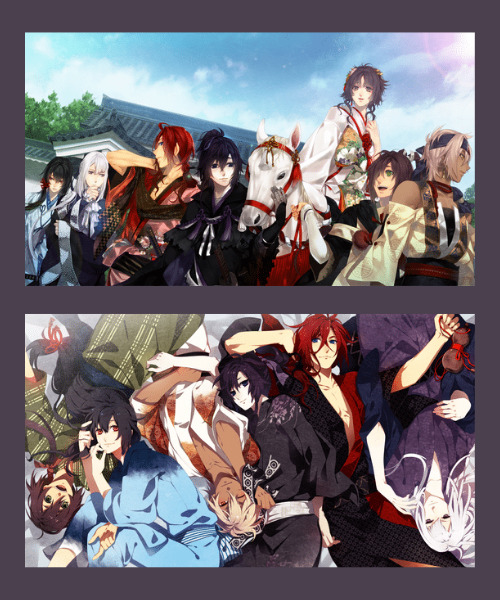
The common route was pretty long as I mentioned, but the story in it especially during the first run through was pretty interesting, the 偽の花嫁行列, basically a secret ploy to transport one of the 天下五剣 (swords that are able to seal 妖怪) to 駿府, the journey filled with encounters with 妖怪 and 山賊, in which the bloody sprites of the six guys looked so cool in. It also introduces the lore and power of the マレビト, and the attempts of 朝倉 宣正 and his cronies to use this power to resurrect someone of importance to the 将軍 using one of the five legendary swords (the same one that was transported to 駿府) held by one of the 一番刀 (鼓 法眼) and a virgin (七重) as a sacrifice to make the ritual work. Not gonna lie, it got a little boring seeing it again and again in the common route, but it always changed a little in every end, so it retained my interest in it.
Other than that, a lot of the journey was horse troubles, probably a standard for anything remotely princess-y themed, which was almost funny to see in a Japanese context. So used to reading about the same runaway horse troubles in Western books and media.
The flowers that suddenly appear when you make a character specific choice suprised me. Never played with anything that had a mechanic like that. Makes choosing the correct route without a guide way easier to notice. It was an oddly specific otoge choice I believe, flower graphics. I wonder how dudes would react if it was the same for eroges or something.
As for the game in general after the common route, I love that everybody still keeps appearing in other routes, and that the game does not pretend that they do not exist anymore simply because you chose a different person. It definitely adds to the depth of each character, and the world really feels full and alive. It also allows the game to hint once again at the potential to read the other routes in game in case you forgot what they were like. The side characters were very much involved in advancing the plot, even characters who I thought were only there as sidekicks had many opportunities to get involved one way or the other.
香夜, the Protagonist
Okay, so I changed her name, even though it was pretty, because self-insert time! My two braincells' pathetic attempt for a 漢字 self-insert name was 命 (めい). Just liked that it meant both life and destiny in definition, and it seemed fitting for what is essentially a dating sim.
Honestly didn't think the name mattered until I realized just how many times they were using the word 命 (いのち), and it became a slight in context guessing game. The name also mattered a lot in one of the routes which I will talk about later.
As for the character itself, the majority of her personality ends up being the damsel in distress type, to my slight disappointment. I was hoping for more 薙刀 action, which she does do in tiny bursts, but there was so little of it, it was almost as if it's there as a prop. The title screen for naming her has her sprite holding it, I feel like I got baited. Very much expectation vs reality, but I guess being an awesome weapon wielder was not exactly the point or goal for her character, especially in the 江戸時代, where women though not subservient to men and were able to participate in jobs and other activities outside the household, still held some clear gender roles and expectations. Also, her role in the 偽の花嫁行列 limits her ability to use her weapon, which a few characters remind her of, but I still would have liked it if she utilized it more than it just being there to make for interesting CGs. It does add a little depth to her family background, and her desire to keep her mother’s memory alive, but it mostly stays at that.
縁

My least favorite route simply because I felt that his character developed way too late in the game. I kept thinking if I had a language learning brainfart, and missed any hints of him wanting to settle simply, but his constant state of drunken stupor and nonstop 軟派 in literally every scene and route he appears in, really did overshadow whatever other personality he had in him.
He essentially wanted nothing to do with being the heir to the next 将軍, even his ownership of one of the 天下五剣 was acquired in farce swordfights, so the power of the sword does not respond to him. He is also extremely clumsy with his swordfighting - which only amplified my doubt in his capability to even handle one of the heavenly swords - and so he ends up getting hurt a lot.
Can't blame him much for hating his life; no matter how comfortable it was, a lot of it was built upon lies and deceit, so he tries to cope with the responsibility that comes with it by drinking and messing around with girls - MC included. Still, he walks around as a spy for the 幕府 looking for the runaway child, missing sword, and 朝倉's crew using his drunken persona as cover - gotta do his job at the end of the day.
Didn't think MC was impressed with him either, as she had to guide and reprimand his every decision like a child right until 柳生 三厳 bared the truth of his background. Was that enough of a turning point for romance to bloom? The truth coming out from somebody else's mouth (yes, I know he was injured at the time) doesn't really sound appealling to me.
荒
His encounter with マレビト ended up looking cool because MC helped him out in harnessing the power of his sword (神降ろし) to seal the gate. MC shows her prowess with the 薙刀 a bit which I still wish we got a common route CG of at least. Anyway, he ends up dying doing his job which I guess makes him kind of a hero. Not the worst way to die.
奇
Much of the same (荒) but he loses his memory instead including his drunken persona and womanizing ways. Isn't it kind of sad that his whole personality revolved at just alcohol and women? He just seemed like an even emptier shell of a person without it - his personality base wasn't anything at all, so he just seemed completely lost just as he started, maybe more.
和
Lady killer can't take no for an answer hunts MC down all the way into the farmlands because he can't cope with the rejection and the pressure of the way of the sword.
He latches on to 螢 and starts helping around as a patrol which he says he liked to do. Still a bit of a leech. Boring end.
幸
Again much of the same (和), but he properly threw everything he had - power, position, and money - for the simple life of a farmer. He genuinely feels interested and happier because of it, so that's good for him. Honestly, they should've made him interact more with 鈴懸, so they could have been plant buddies, and it could have added a different and better build up to him becoming a farmer.
鈴懸
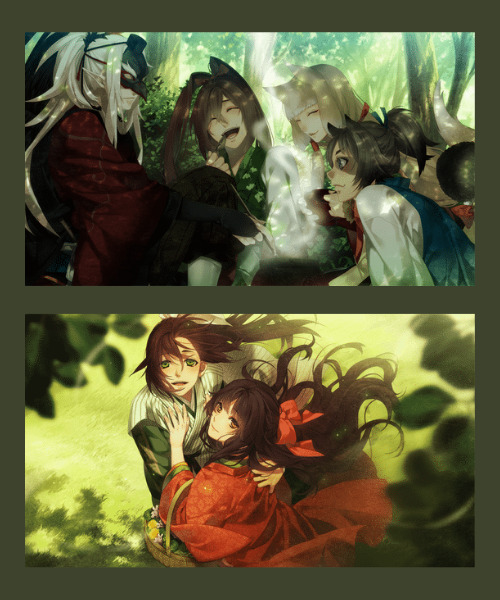
I actually liked this route, feels bad man that it has to sit at 5th, because every other route appealed to me more, if only because of his age and really childlike curiousity with everything. I really thought of him more of like a friend or little brother for MC, so you better believe the kind of whiplash I got when they're suddenly confessing their undying love for each other. Yup, kinda forgot I was reading a otoge/dating sim, whoops.
If I had to describe this entire route, it's warm, mostly because of how the CGs are presented. It's such a lovely take on 妖怪, how not all of them are bad and evil beings, and it reminds me very much of 夏目友人帳, which is one of my favorite male protagonist shows for a 少女アニメ/漫画.
They present him a lot as a diplomatic and kindhearted doctor, but he does not back down from a fight if he needs to which makes perfect sense since he's been fated to wield one of the 天下五剣, the same one that got transported to 駿府, something that I was not expecting. He's just an all around nice guy, who would pick talking over problems more than stabbing at them, but I guess the heavens pick (semi-)decent people to hold that kind of power.
荒
He essentially just wins at life: he wins the tournament, one of the coveted 天下五剣, and a position in government, because he's both an excellent doctor and swordsman, all in exchange for less time with MC, but man, at least he's alive. Good for him, but it honestly made me super salty over the death of a different character which I will get to later.
奇
He dies protecting a doggo 妖怪, like seriously, how is this one the unconventional end? His actions felt both like a brave and stupid thing to do, but also very much in character. Can't be mad at character deaths that make sense.
和
I loved the idea of the 木霊 only talking to you if you're pure of heart - something both the MC and 鈴懸 acquire and reacquire respectively. This also opened a pretty interesting dynamic with 薬師院 神威, a government employed apprentice doctor, who only wants to be recognized by his 師匠. Too bad though, the old guy has the hots for 鈴懸 lmao. They end up bringing the kid to youkai land which was really kind.
幸
Again, the only good people/妖怪 that actually cared about the kid being mixed in such a mess, probably because 鈴懸 got left behind as a kid as well and can relate to the struggle. It might not have been this route in particular, but I really started to despise 鼓 法眼 after a while since he either kept abandoning the kid in such awful situations or was willing to sacrifice the kid's life instead of 七重. Anyway, nice turn of events where they ended up living their peaceful lives in youkai land with the kiddie. I'm sorry I can't remember Chorizo's name in kanji for shit. Choushichirou.
螢

Not gonna lie, usually don't like tsundere types, but it made sense after it was revealed that he was an 鬼. It caught me off guard and made me much more interested in his story, because I was rather detached with his personality otherwise. Tragic childhood memory of his village being raided by humans and his family getting killed is standard fuel to get him to try and get back the right of his people to wear swords again to defend themselves.
He had a nice personality contrast - always angry to the point of violence, but he also just wants to use his prowess with swords to defend others, so he ends up with one of the sweetest ends in game. It honestly made me smile many times.
荒
He wins the tournament, but gets stabbed and dies afterwards. I thought this was one of the saddest ends in game, because all goes well at first and then it suddenly turns very sour right at the end. Terrible things happen when you take detours apparently.
奇
This was weird, but it was so nice seeing the gang back together to set up an instant marriage ending for the two who kept going around in circles.
和
The introduction of a fianceé by his grandpa felt rushed and was also resolved very quickly. It's basically just there to ruin his chances of winning the tournament, which gets puts aside to prioritize his elopement with MC.
幸
Dad highly opposes the relationship between MC and 螢, because of his background. Fair enough and makes sense until I realized he doesn't comment much about the stuff that goes down in 左京's route. Dad has double standards. Still, the whole sequence of him being challenged to pick a thousand flowers, all the way to the scene of them getting married in 鬼 land made for a satisfying buildup to best end.
黒羽 実彰

This was the first route I played in game, and it was my favorite right until I started the next two routes in this list. This was also my first 100k read ever - I couldn't stop myself from reading most of it in one go especially because it flowed directly after the common route. Any time he's in a swordfight, and goes either 「甘い」or 「遅い」 - chef's kiss.
I generally find the discussion of religion in reads fascinating, especially when it discusses a faith that compose only a tiny percentage of the population. Seeing 黒羽 take time for himself to practice the teachings of his faith, while also hiding the fact from everybody else, because he was going to be ostracized and persecuted for it, made me very interested in him. That and the fact that he's a master swordsman trying to run away from the way of the sword, but can't because he carries not just one of the 天下五剣, but a sword possessed by a playful 妖怪, ハバキ憑き, no less.
A secret Christian in the 江戸時代, with a dark murderous past, wielding a sword both possessed by a spirit and one capable of sealing them. It's so good! Really enjoyed how the dynamic of all of those things worked together to form this highly religious, gentle, and mature character.
荒
お松's revenge, since 黒羽 accidentally killed her sister, made for another layer of my interest in this character. He ends up continuing his life as a samurai, but now to protect MC and everybody around her, as atonement for his sins - again a very religious way of doing things. It's a perfectly bittersweet end, that I don't really have any complaints about.
奇
Again, reading straight from my first play through of the common route right to this epic ending just made me love this game from the get go. This is also the end that made me rather salty about 鈴懸 living a rather good life in 荒, when three time tournament winner and master swordsman 実彰 gets sucked into the void never to be seen again instead. How? Make it make sense! It was a fantastic first ending to play through though, I just can't get over the fact that 鈴懸 somehow beats 実彰's swordsmanship and apparently his ability to wield the one of the 天下五剣, too. Noooooo! ٩(๑`^��๑)۶
和
When he suggested that MC stay over at his house for the night...to avoid the 妖怪 of course. (〃ω〃) What a spicy thing to suggest, coming from a devout Christian.
He puts aside his sword and settles down with MC and helps out at the 茶屋. This also still makes sense, but it was so disappointing to see him throw away all his potential for the simple life. He's just a master at handling knives at the chef's station now. This feels more unconventional if anything.
幸
お松's forces him to confess that he wants to live his life with MC and not only accept death as atonement for his sins. He then whisks away MC and marries her eventually to avoid the 幕府. He also leaves his sword with the church, with the promise to only take it again in a dire situation. After 7 hours of reading, my heart was so full, and that's all you need to know.
鷺原 左京

Oh boy. I felt the need to atone for my sins like 実彰 after reading this one and liking all the insane stuff that went down. Once again, this game just blew my expectations out of the water. To be honest, he felt really feminine - the true pretty boy among pretty boys - and I thought that this was was going to be the standard revenge plot, made exciting because he doesn't hold back at all, but the 剣 ends in this were crazy good!
He's also the character where I thought MC's dad was the most oblivious of. There literally was a guy in his daughter's room for more than a week, and he barely even noticed, or was just letting things slide. He also is more unaware that compared to 螢, 左京 is generally more violent, and have a deep-seated hatred that have led to evil tendencies. He's possibly just blinded by how everyone introduced him as MC's 恩人 - essentially a good human being in any doting parents' eyes.
We also see all the gentle sides of him while he was recovering at MCs room. The transition from really kind teacher to uncontrollable murderer due to wielding the cursed sword, 村正, was so thrilling to read. Bloody sprites with crazy eyes, yes! It reminds me of Grog from Critical Role (popular D&D streams, if you aren't familiar) when the cursed sword he possessed was also convincing him to kill and how difficult the rolls were to beat that urge down, so I knew just how deep of a crazy circumstance 左京 had fallen into.
荒
He stabs MC to death and panics after realizing what he has done, and decides that the only way to stop was to kill himself and take the sword down with him. They both end up in the underworld, only to discover that 左京's crimes were too much so they still can't be together, so logically MC just dives into the pits of hell with him. Girl...you're insane.
It was awesome though, because it was the first route I've read that went beyond death, and actually showed what goes down in the afterlife. It was the most twisted end in the game, hands down.
奇
Just as crazy as the last, but 左京 doesn't pull MC to hell with him and she survives. She instead proceeds to go on a 墓参り for every victim that fell under 左京's sword. Not really the strangest thing to do, since technically 実彰's whole reasoning in joining the 花嫁行列 was the same - to pilgrimage to the gravesite of お松's sister. It's the kind and right thing to do if anything.
和
He recovers his original family sword and unlocks...special firefly powers? The whole gang is here again in an epic fight scene with bonus height difference screens. lmao
He goes back and to rebuild his clan with MC as his wife. This was honestly really cute, and a good recall to the original 花嫁行列, only it's not fake this time. I wish we got either another full cast CG or a bridal image even though in the CG that we did get he just looks like a bride anyway.
幸
He stays with MC and plans to build a school for children. Very nice to see the human side of him come through again after the whole revenge plot insanity. Pretty boy deserves some peace and happiness, too. (´∀`✿)
九十九丸

My two braincells insisted on reading his name as 99○, but thank goodness I got used to reading his name properly before his route started, because I would have been so annoyed at myself for memeing through literally the best route in game, once again reading 100k of in 6+ hours. I'm geniunely so glad I followed a guide, because I would have picked his route if not first or next to 黒羽.
It's either I'm blind or can't pick up hints, but once again, his route blew all my expectations out of the water. I literally was able to observe most if not all his quirks, and yet, I still wasn't able to perceive what he really was. He's cheerful, clumsy, and goofy at times, but still shrouded in mystery. He's pale and cold to the touch with a stomach of iron, it smells like incense whenever he's around (he literally lights some for MC in the common route! Gigantic hint.), he has a black pet messenger bird, and that he was fascinated with competing at the tournament to bring back the victory of to his hometown along with a scroll or something for his master. The 妖怪 also run away from him for no apparent reason. They even ask him about the scar on his chest in the 温泉, and that he has a perpetually bandaged arm, and yet I took all of this information at face value, thinking that he just is one of the types to like to proudly wear his battle scars. Not gonna lie, it was probably a good thing, because I would have anticipated it and could have enjoyed it less.
Before reading his route, I was already thinking how useless the マレビト was as the main enemy in the game, because he gets sealed away again and again in every end, making MC's whole dream sequence feel really shallow. Evil thoughts as they are, I wanted to see the town actually burn to the ground, and for the 妖怪 to properly wreck havoc, and it wasn't happening. Granted, it still didn't happen, but the way it worked out made up for it.
Anyway, he ends up competing in the tournament, only to suddenly harness the power of the マレビト whenever he's about to lose.
Turns out that this entire time, the attempts at the resurrection ritual that I've been skipping repeatedly when possible, has been done before to the 15 year old body of 九十九丸 and that the マレビト has been essentially absorbing his lifeforce for the past five years. His dad sacrificed himself to the マレビト to bring his son back, but because it was a forbidden ritual, nobody wants anything to do with either of them.
Poor zombie 九十九丸, his arm already in decay, has been eating so much because he desperately wants to grow up more, and yet he can't because he's technically dead, and a part of his being was stolen away.
You can imagine how floored I was when everything clicked into place in my brain.
He's also the character that asks for permission to name his sword after the MC, which means my self-insert name, 命, gets a really poetic meaning because it's literally life and death. Things work out.
荒
He was essentially told to control the マレビト by bathing in the moonlight. He was also given a vial of healing water to be used for when he is gravely injured. MC then uses said water to revive him and bring him back from the endless battle with the 妖怪 in the afterlife. He then goes into pilgrimage to the gateways to rid himself of the マレビト, and so he leaves and continues sending letters to MC through ハヤト.
Pretty dramatic, but not the worse end by any means. He could have been permanently dead, and the マレビト could have just taken over, wrecking havoc like I once wanted to. Talk about a proper game over screen.
奇
He buys into the マレビト's logic and proceeds to go into pilgrimage to properly harness it's power instead of trying to suppress it.
It's super messed up and creepy, because the power he's about to harness is evil at its core, and for him to use it to what end? It's another rampage waiting to happen.
和
They journey back to his village to learn about the truth, only to discover that he could properly lose his life in the process, and he does because he gives up after his master gets engulfed and MC almost did, too.
MC becomes a shell of her old self without 九十九丸, and eventually finds herself back at the meadow where the マレビト I tricks her into coming with him.
The part where he says 「常世へようこそ」 in the creepy マレビト voice, is literally my favorite lines in the entire game. It's so creepy! It also means MC was a 馬鹿 and we lost 九十九丸 for nothing.
幸
The most epic battle scene in the game where 九十九丸 battles his マレビト self. We also get to see MC fight with the 薙刀 for literally two seconds before she stops because it hurts both versions. Girl keeps making me hope for more.
Somehow マレビト just ends up giving 九十九丸 his life back. Probably rolled a D20 charisma check to convice him. Absolute troll D&D logic kind of ending. The writers just needed to write an actual good end at this point so they just wrapped it up with a bow, and pretended that we won't notice that it barely makes sense. Everyone goes back home and is happy, and we get 20 year old, hot version 九十九丸. The end.
Writing it now makes it so underwhelming in hindsight, but who cares, it's over and it was still a pretty epic turn of events overall.
ご褒美 (貸本屋)
We also get some bonus stories where the guys switch clothes in their dreams while they were lodging together in the common route. Slightly funny, almost BL fantasy, that made me realize how much slower I read in 縦書き. Time to read more books or a least try reorienting the texthooker page.
-☆-
This was me struggling to write all my thoughts for like half a day. Why do I feel like it's physically impossible for me to write a half decent and short review, geez. Don't know what to do with my life now until I find something decent to read again (maybe, Eustia?).
Anyway, thanks for reading and updates in the future as always. ʕ•̀ω•́ʔ✧
#language learning#japanese language#language acquisition#study blog#langblr#studyblr#language immersion#japanese#japanese langblr#日本語#ken ga kimi#剣が君#otome game#japanese studyblr#visual novel#visual novels#vn review
16 notes
·
View notes
Text
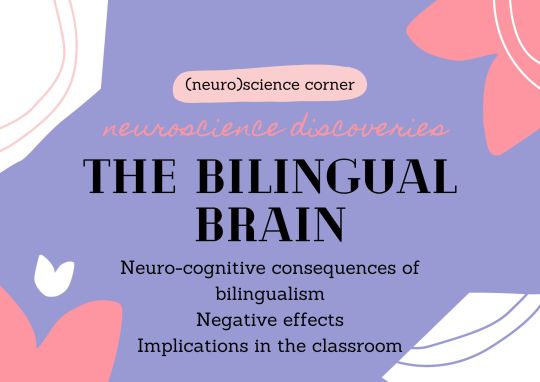
Bilingualism is a hot topic right now, both in academia and amongst, for instance, parents, trying to decide what’s best for their child. And while it is obvious that being able to speak two languages from a young age is beneficial in many ways (language capacity, job opportunities, communication benefits, travel opportunities, etc), today I want to talk about this from a neuroscience point of view. So, what are the neuro-cognitive consequences of bilingualism?
The definition
A bilingual person, according to Oxford and Cambridge dictionaries, is a person who is able to use two languages equally well. In science bilinguals are separated into two groups - simultaneous (for instance, children growing up with two languages coming from their parents) or sequential (learning one language after another).
A little bit of history
The first systematic studies were actually aimed at demonstrating the negatives of bilingualism. For instance, Saer in 1924 showed that the average IQ of bilingual Welsh-English kids from rural areas was actually 10 points lower than monolingual kids from the same area. However, this study has not taken into accountability many of the other variables, like education, socioeconomic status, etc. Right now we understand that those results are not necessarily reliable, but at the time those claims were pretty influential. It led to many claims, including such saying that mastering two languages diminishes one’s capacity to learn other things. But that is not how our brains work (thanks to neuroplasticity). Learning one thing does not push out some other skills, possibly only the knowledge that is not constantly used. The first positive correlation between bilingualism and cognitive performance while also controlling other factors was found in the 60s.
Second language in the brain
Neuroimaging has shown us what regions are involved in processing speech, and it is consistent across many studies that those regions are shared when more than one language is involved. So a new language doesn’t activate some new parts of your brain.
How does a person choose the right language?
Evidence shows that both languages are activated in the brain and they are competing, so when a bilingual person wants to use one language (for instance, to hold a conversation), they are inhibiting (suppressing) another language. This led to a claim that bilinguals are better at suppressing unwanted information in general, not only when it comes to language. Many studies were done on children, adults and patients with dementia to find support for the claim. While the claim itself is a bit more “black and white”, there is evidence that bilinguals are just slightly better than monolinguals when it comes to focus and concentration and avoiding distraction in situations when there is competing information (like trying to hold a conversation when there are others talking loudly around you). And as this ability declines with age, it has been also shown that this decline starts later in bilingual people than monolingual.
Why is this claim controversial?
It promises a lot by being relatively simple. Evidence is not consistent (some studies just don’t have enough participants), not all studies include factors that can influence the results, like the age of language acquisition, whether it was done simultaneously or sequentially, etc. Another interesting claim is the “chicken and egg” problem - does bilingualism influence cognition, or does one’s cognitive ability influence the likelihood of successively acquiring a second language?
Other benefits of bilingualism
Meta-linguistic knowledge, in a way that they can separate the word, or the label, from its image.
Better understanding of the “theory of mind”, or the general awareness that people have different sets of knowledge. It is common for small children to assume every adult they speak to knows everything they do and they get amused when they find out it is not true. Bilingual children due to their experience grasp the concept better.
Associating one language with home can also increase the sense of belonging and deepen parent-child relationships.
Better decision-making, because people are less instinctive in a foreign language, therefore being able to be more cold-headed. For example, if asked whether it’s worth pushing a man in front of a train to save five other lives, respondents are more rational than moralistic when considering the question in a non-native language.
Disadvantages of bilingualism
Size of vocabulary. Bilingual people simply use some words less often than monolingual people do, because it is easier to recall a term if you only have one label for it, rather than when you have 2 labels for one thing.
The “tip of the tongue” experience (when you cannot remember a simple word).
Classroom implications
Those findings have some implications in the classroom. For example, as bilinguals are more sensitive to social cues, they might have easier time learning in a social context, through interaction, etc. There is still ongoing research, but there are suggestions that bilingual people might be more attentive, engaged in the classroom, and even be more empathetic than their peers.
Dr Bozic’s lab findings
Dr Bozic’s lab was doing research at the time that put aside the concept of “bilingual advantage”. They were simply looking at if there would be a difference in the brain activation of bilingual and monolingual participants doing the same task. They were given a story with three different background noises - something being said in the languages they understand, the language they don’t understand, and a background noise that makes no sense, it’s just noise. While brain activity in monolinguals was increasing with the increase of hearing environments (from noise to hearing language they understand), there was no difference in how strongly information was encoded in the brains of bilinguals. So, while monolinguals are boosting their encoding to understand the story they are hearing, bilinguals don’t, and yet they both succeed.
Sources:
https://www.youtube.com/watch?v=TgSzvvCrLno&ab_channel=BritishCouncilSpain
https://www.theguardian.com/books/2020/feb/11/the-bilingual-brain-albert-costa-language-review
#neuroscience#biology#science#brain#language#english#spanish#bilingual#cognition#brain imaging#research
2 notes
·
View notes